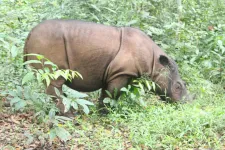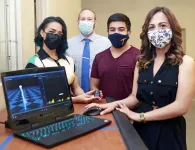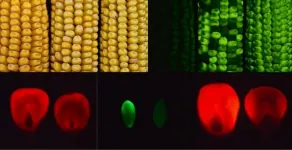(Press-News.org) Today, the Sumatran rhinoceros (Dicerorhinus sumatrensis) is critically endangered, with fewer than 100 individuals surviving in Indonesia on the islands of Sumatra and Borneo. To ensure survival of the threatened species, accurate censusing is necessary to determine the genetic diversity of remaining populations for conservation and management plans.
A new study reported in BMC Research Notes characterized 29 novel polymorphic microsatellite markers -- repetitive DNA sequences -- that serve as a reliable censusing method for wild Sumatran rhinos. The study was a collaborative effort involving the University of Illinois Urbana-Champaign, the Eijkman Institute for Molecular Biology in Indonesia, Queen's University in Canada, and the San Diego Zoo.
"It's hard to do population censusing for this species because there's not a ton of them and they're very elusive so it's hard to figure out how many there are," said Jessica Brandt, former PhD student in the Roca lab who led the study. "We were looking for ways to do that without handling the species. This was a joint effort between groups of people who were interested in working on these endangered species and contributing to their management."
Sumatran rhinos live in dense rainforests that are hard to traverse through, making it difficult to track Sumatran rhinoceros populations. The researchers relied on fecal DNA collected from Sumatran rhino dung samples, requiring little interaction with individuals in the wild. Although dung sampling poses many benefits, fecal DNA can be degraded and the age of the samples hard to determine. In order to overcome these challenges, researchers designed optimized microsatellite markers that were short and easy to amplify from dung samples.
"Microsatellite markers are found in non-coding regions and because of that, they evolve pretty quickly," said Brandt. "They're really useful in populations where you want to identify individuals because you're going to see more variation at those particular markers than if you're using a protein-coding gene."
"During replication of the DNA, these markers can very easily expand or contract like a genomic accordion" said University of Illinois Urbana-Champaign animal sciences professor Alfred Roca, also a member of the Carl R. Woese Institute for Genomic Biology. "By looking at enough of these markers, you can distinguish animals because microsatellites evolve very quickly and are highly variable within species. These markers are ideal to target regions of the rhino genome that are highly variable."
Using high quality DNA sequences from captive Sumatran rhinos, researchers identified 29 polymorphic candidate loci for further optimization. To test its utility for censusing, 13 of the 29 markers were randomly tested on fecal samples collected from wild Sumatran rhinos. The researchers were able to amplify nine of the markers from 11 wild fecal samples.
"The combination of these markers yielded better statistical power for identifying Sumatran rhino individuals and amplified very well when tested using non-invasive samples," said Sinta Saidah, co-author and research assistant at the Eijkman Institute for Molecular Biology in Indonesia. "We hope that we can use these markers on more samples collected in the field to provide island-wide population data for Sumatran rhinoceros species, which will help us devise better conservation strategies for this critically endangered species."
"To make a conservation plan, you have to know who's there and what their current level of diversity is," said Brandt. "Our markers would allow the Indonesian officials to determine not just how many rhinos they can count but whether or not they're related. Ultimately, another goal would be to expand this research to include other endangered rhinoceros species."
INFORMATION:
Other authors of the study include Kai Zhao, Isabella Apriyana, Oliver Ryder, Widodo Ramono, Herawati Sudoyo, Helena Suryadi, and Peter Van Coeverden de Groot.
Funding was provided by the US Fish and Wildlife Service Rhinoceros and Tiger Conservation Fund, the International Rhino Foundation, the Ministry of Research and Technology/National Research and Innovation Agency of the Republic of Indonesia, the World Wildlife Fund, the National Science and Engineering Research Council, and the Illinois ACES Office of International Programs.
Boulder, Colo., USA: A new focus article in the May issue of Geology summarizes research on plastic waste in marine and sedimentary environments. Authors I.A. Kane of the Univ. of Manchester and A. Fildani of the Deep Time Institute write that "Environmental pollution caused by uncontrolled human activity is occurring on a vast and unprecedented scale around the globe. Of the diverse forms of anthropogenic pollution, the release of plastic into nature, and particularly the oceans, is one of the most recent and visible effects."
The authors cite multiple studies, including one in the May issue by Guangfa Zhong and Xiaotong ...
UNIVERSITY PARK, Pa. -- As more people go online for shopping, understanding how they rely on e-commerce recommendation systems to make purchases is increasingly important. Penn State researchers now suggest that it's not just what is recommended, but how and why it's recommended, that helps to shape consumers' opinions.
In a study, the researchers investigated how people reacted to two product recommendation systems. The first system generated recommendations based on the user's earlier purchases -- often referred to as content-based recommendation systems. ...
EL PASO, Texas -- For more than a year, researchers at The University of Texas at El Paso's Stanley E. Fulton Gait Research & Movement Analysis Lab in the College of Health Sciences have been using real-time 3D animation to investigate motor impairments in children who have autism spectrum disorder (ASD). Their aim is to understand how children with autism can learn motor skills, so that they can receive effective therapies.
The results of their study, titled "Children With Autism Exhibit More Individualized Responses to Live Animation Biofeedback Than Do Typically Developing Children," were recently published in the journal of Perceptual and Motor Skills. The paper's release coincides with National Autism Awareness Month in April.
"The greatest takeaway from this study is that when teaching ...
UNIVERSITY PARK, Pa. -- Tweaking the look of a social media profile may subtly alter a person's reaction to the health messages that appear on that site, according to researchers. They add that these reactions could influence whether the users heed the advice of those messages.
In a study, the researchers found that people who gained a feeling of control when they customized an online website were more likely to perceive the health message as a threat to their freedom, lowering the chance that they will adopt the message's advice. On the other hand, when customization bolstered the users' sense of identity, they did not resent the message as much and were more willing to consider the ads' recommended behavioral changes, according to the researchers.
"In ...
Ensuring that veterans have stable housing not only reduces homelessness but also slashes the cost of providing them with publicly funded health care, according to a national study led by University of Utah Health scientists. The researchers found that veterans who received temporary financial assistance (TFA) from the Department of Veterans Affairs (VA) to acquire or retain housing had fewer hospital visits and an average reduction in health care costs of $2,800 over a two-year period than veterans who did not receive this benefit.
The researchers say this model could help non-profit organizations and other federal, state, and local governments better serve homeless Americans who are not veterans.
"Getting ...
Black and Latino neighborhoods in the 30 most populous U.S. cities had fewer pharmacies than white or diverse neighborhoods in 2007-2015, USC research shows, suggesting that 'pharmacy deserts'- like so-called food deserts-may be an overlooked contributor to persistent racial and ethnic health disparities.
Pharmacies are increasingly vital points of care for essential health services. In addition to filling prescriptions to treat chronic health conditions, pharmacists dispense emergency doses of naloxone to reverse opioid overdoses, contraceptives to prevent unplanned pregnancy and COVID-19 testing and vaccinations.
But ...
More than 25% of the world's population (greater than 1.5 billion people) face the burden of soil-transmitted helminth (STH) infections, a species of intestinal parasite whose eggs develop in the soil before finding a new host. The main cause of this high infection rate is lack of access to adequate sanitation facilities (toilets) and the consequent contamination of the environment with human feaces. While universal access to adequate sanitation is one of the sustainable development goals, parasite burdens are still causing harm. Fortunately, deworming medicines are highly effective and safe. Researchers from Syracuse University, the World Health Organization, ...
A year into the COVID-19 pandemic, mass vaccinations have begun to raise the tantalizing prospect of herd immunity that eventually curtails or halts the spread of SARS-CoV-2. But what if herd immunity is never fully achieved - or if the mutating virus gives rise to hyper-virulent variants that diminish the benefits of vaccination?
Those questions underscore the need for effective treatments for people who continue to fall ill with the coronavirus. While a few existing drugs show some benefit, there's a pressing need to find new therapeutics.
Led by The University of New Mexico's Tudor Oprea, MD, PhD, scientists ...
An abnormal build up of carbohydrates -- sugars and starches -- in the kernels and leaves of a mutant line of corn can be traced to one misregulated gene, and that discovery offers clues about how the plant deals with stress.
That is the conclusion of Penn State researchers whose previous study discovered the Maize ufo1 gene responsible for creating the mutant corn line. They now are assessing its effects and potential for inclusion in breeding new lines of corn better able to thrive in a warming world. The finding of higher sugar levels in plant tissues in their latest study is just ...
May 3, 2021
Using social values for profit cheapens them, a new study cautions.
Toronto - Businesses sometimes align themselves with important values such as a clean environment, feminism, or racial justice, thinking it's a win-win: the value gets boosted along with the company's bottom line.
But be careful, warns new research from the University of Toronto's Rotman School of Management.
Using these values primarily for self-interested purposes such as profit or reputation can ultimately undermine their special status and erode people's commitment to them.
"It sets a different norm for appropriate use of the value," says research author Rachel Ruttan, an assistant professor of organizational behaviour and human resources at the Rotman School, who ...




